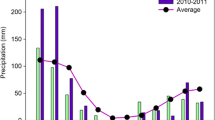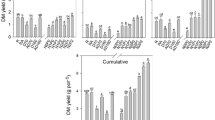Abstract
The15N isotope was used to study the mode of action of individual nitrogen sources in a 30% urea:30% ammonium nitrate: 10% ammonium sulphate:30% filler (w/w) granular fertilizer for perennial ryegrass in a greenhouse pot experiment. The fertilizer consisted of two types of granules, one containing 80% urea and 20% filler and the second containing 48% ammonium nitrate (AN), 16% ammonium sulphate (AS) and 36% filler. In addition the effect of dolomite compared with silica as the filler was investigated on nitrogen recovery from the 30:30:10:30 formulation.
Dolomite adversely affected the recovery of nitrate N from the system and evidence suggested that MgCO3 was the active component. Granules containing dolomite resulted in a lower dry-matter yield than those containing silica, however the difference was not significant as nitrate contributed only 20% of the N in the formulation. AN gave the greatest DM yield and urea the lowest with AS being intermediate. The15N budget in shoots, roots and soil indicated that only 65% of the N from urea was recovered at the end of the experiment compared with 86% for AN and 91% for AS. The dry-matter yield of the 30:30:10:30 formulation using silica as the filler was intermediate between urea and AN; however, the apparent N recovery was significantly higher than expected from the sum of the individual components. The use of15N labelling indicated that using separate granules for ammonium N and urea the recovery of urea was improved by 11% in the triple N mixture when both AN and AS were present in the second granule compared to the recovery on its own. The enhanced recovery of urea appeared to be a function of AN and AS acting together as neither source in double combination with urea had any effect on urea N recovery.
Urea enhanced the recovery of nitrate N by 10% but decreased the recovery of AS by 6% (in the 30:30:10:30 formulation) in comparison with the single sources on their own. The results indicate that interactions can occur between N sources even when they are physically separated by being in different granules.
Similar content being viewed by others
References
Adams F and Martin J B (1984) Limiting effects on nitrogen use and efficiency. In Hauck R D (ed.). Nitrogen in crop production, pp 418–426. Madison, Wisc: ASA, CSSA, SSSA
Fenn L B, Matocha J E and Wu E (1982) Substitution of ammonium and potassium for added calcium in reduction of ammonia loss from surface-applied urea. Soil Sci Soc Amer J 46: 771–776
Fenn L B and Hossner L R (1985) Ammonia volatilization from ammonium or ammonium-forming nitrogen fertilizers. In: Stewart B A (ed.), Advances in Soil Science Vol I, pp 123–169. New York: Springer-Verlag
Garrett M K (1987) The rationale for mixed ammonium nitrate-urea fertilisers and assessment of granule products. Proceedings of The Fertiliser Society (London) 257, 36 pp.
Ministry of Agriculture, Fisheries and Food (1979) Fertilizer recommendations for agricultural and horticultural crops. GFI, HMSO, London
Ministry of Agriculture, Fisheries and Food (1981) The analysis of agricultural materials. RB427, 2nd edn., HMSO, London
Preston T and Owens NJP (1983) Interfacing an automatic elemental analyser with an isotope ratio mass spectrometer: the potential for fully automated total nitrogen and nitrogen-15 analysis. Analyst 108: 971–977
Sinclair A G (1973) An ‘Auto Analyzer’ method for determination of extractable sulphate in soil. New Zealand J Agric Res 16: 287–292
Stevens R J and Watson C J (1986) The response of grass for silage to sulphur application at 20 sites in Northern Ireland. J Agric Sci Camb 107: 565–571
Van Burg P F J, Dilz K and Prins W H (1982) Agricultural value of various nitrogen fertilizers. Netherlands Nitrogen Technical Bulletin 13, Agricultural Bureau of the Netherlands Fertilizer Industry. The Netherlands
Van Rheinbaben W (1987) Effect of magnesium sulphate addition to urea on nitrogen loss due to ammonia volatilization. Fert Res 11: 149–159
Watson C J (1987) The comparative effects of ammonium nitrate, urea or a combined ammonium nitrate/urea granular fertilizer on the efficiency of nitrogen recovery by perennial ryegrass. Fert Res 11: 69–78
Author information
Authors and Affiliations
Rights and permissions
About this article
Cite this article
Watson, C.J. The comparative effect of a mixed urea, ammonium nitrate, ammonium sulphate granular formulation on the efficiency of N recovery by perennial ryegrass. Fertilizer Research 14, 193–204 (1987). https://doi.org/10.1007/BF01050664
Accepted:
Issue Date:
DOI: https://doi.org/10.1007/BF01050664




